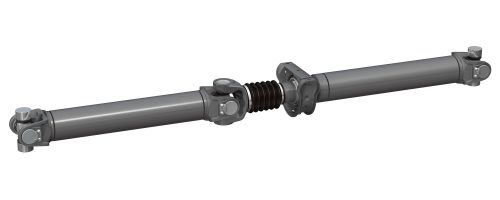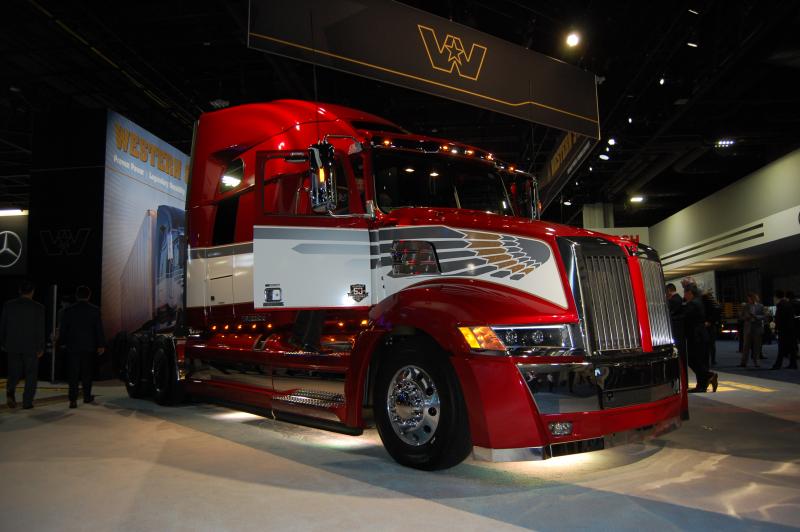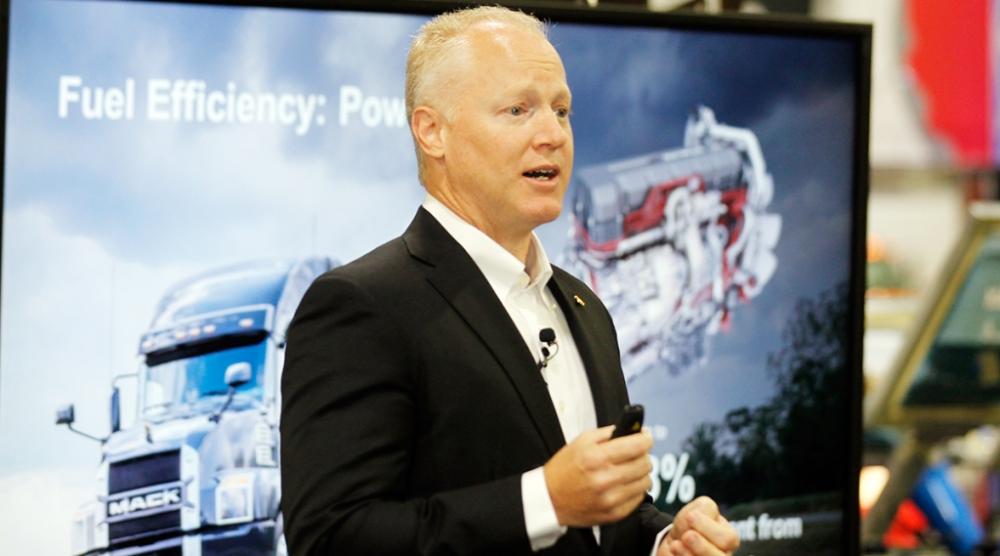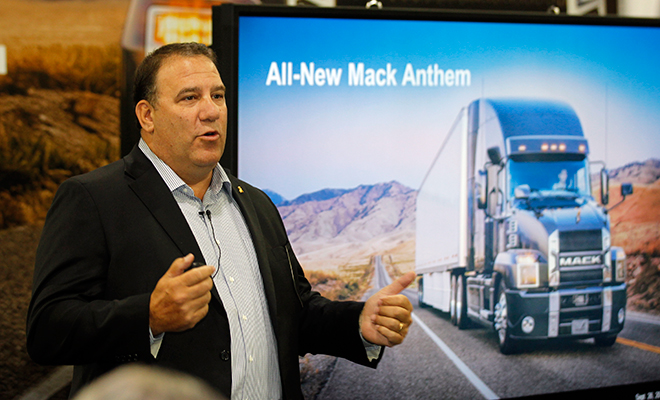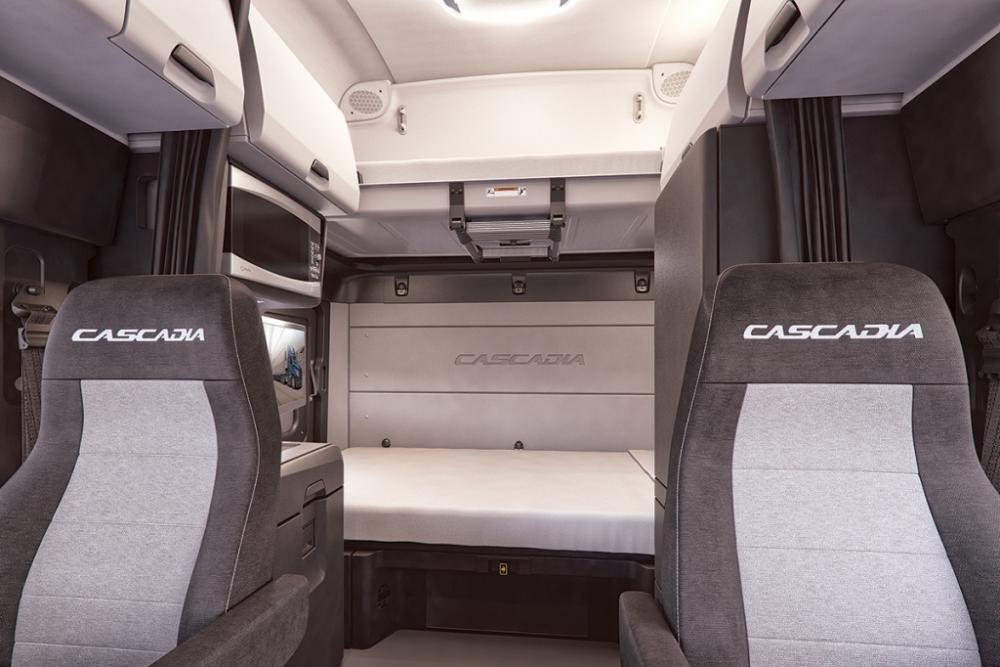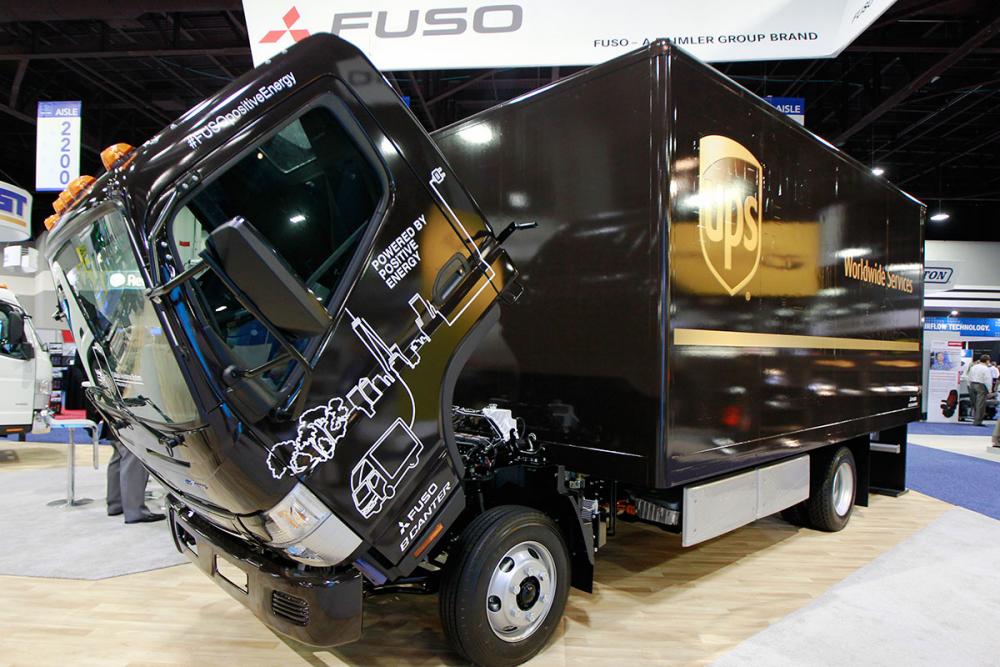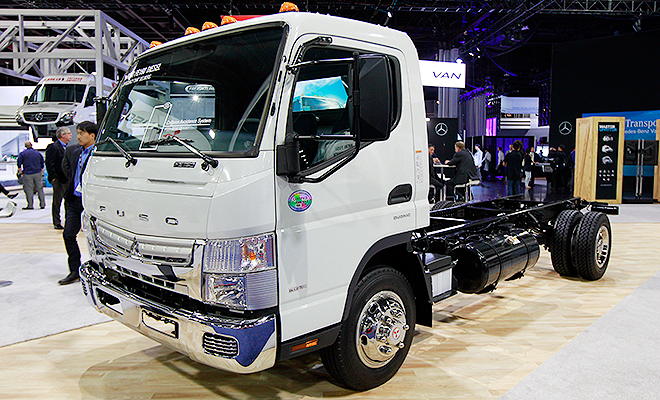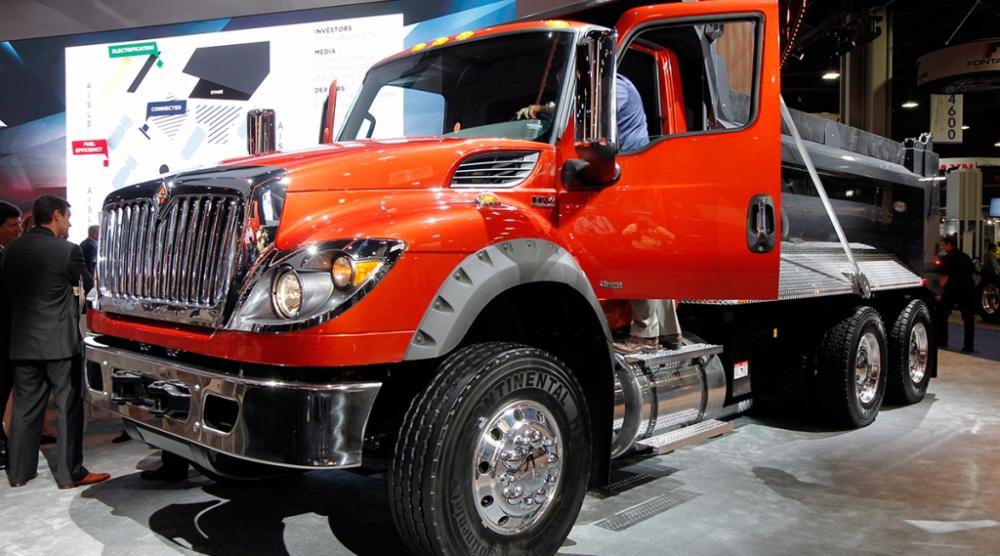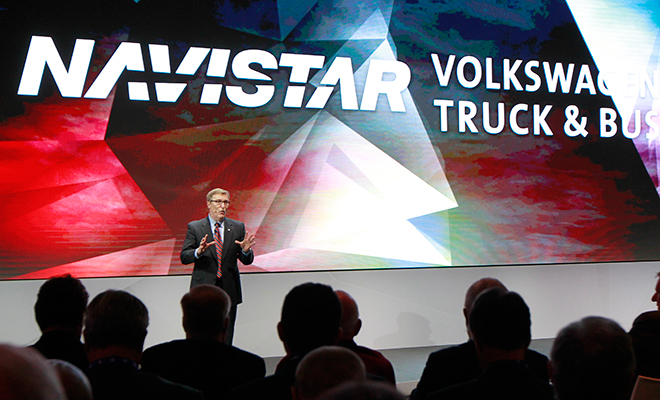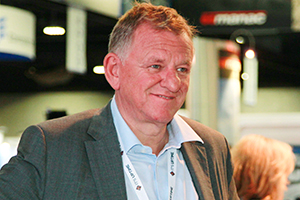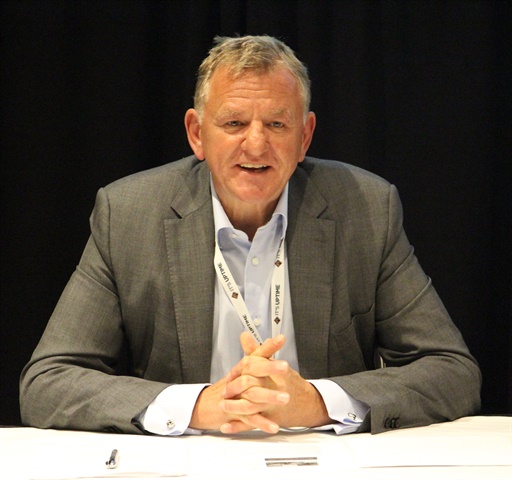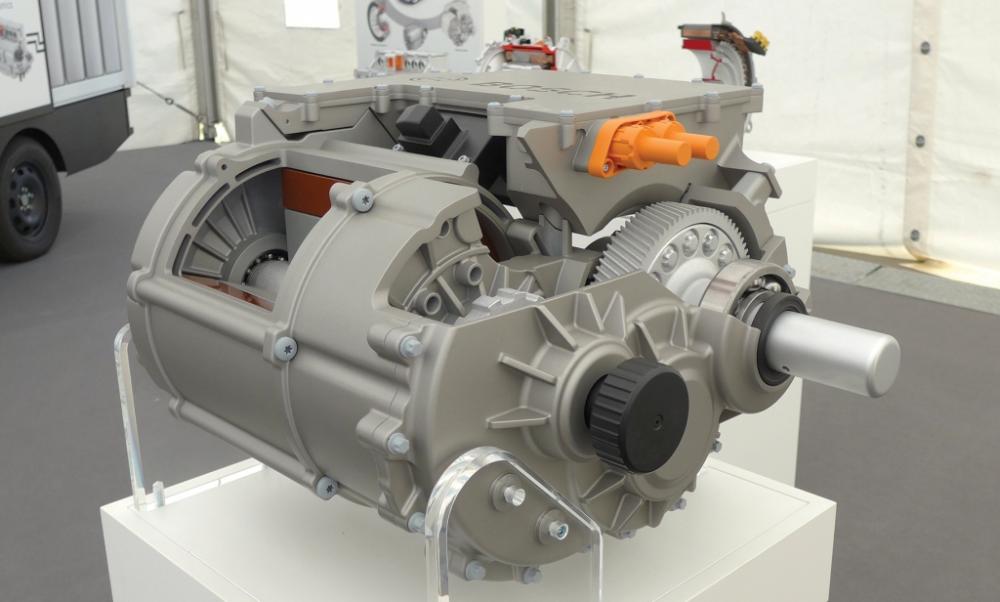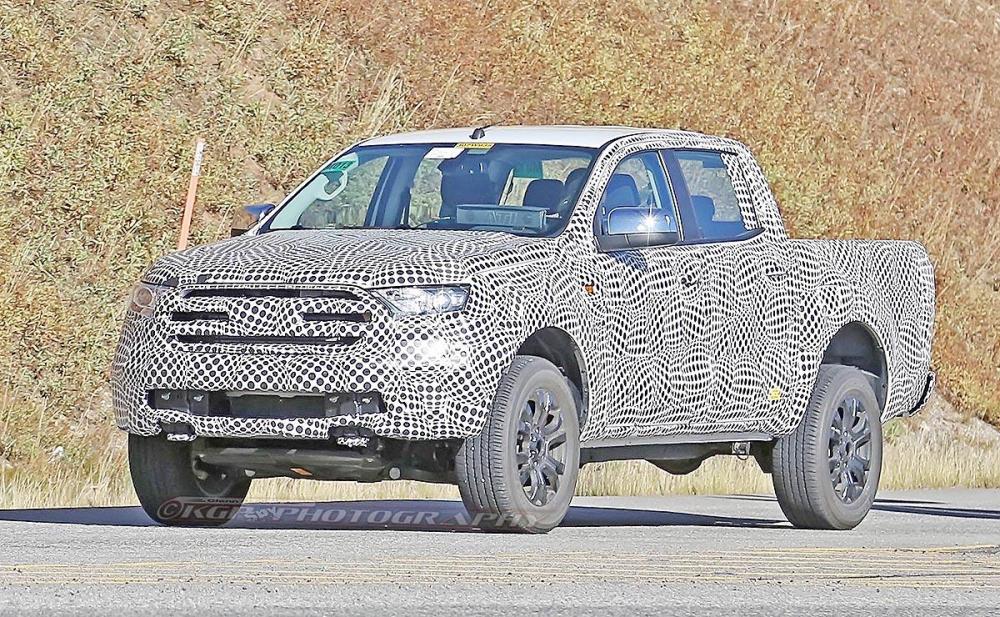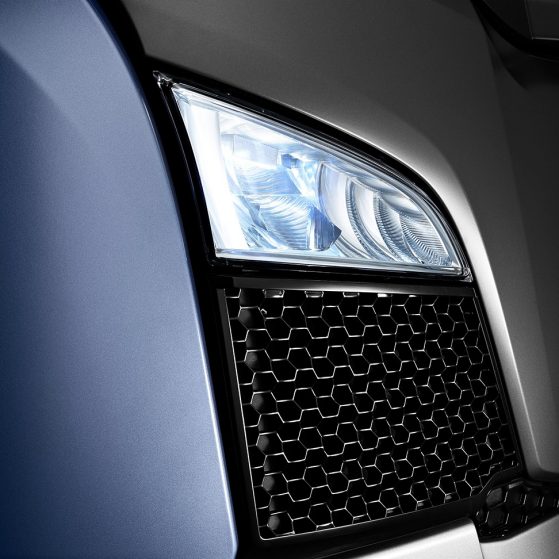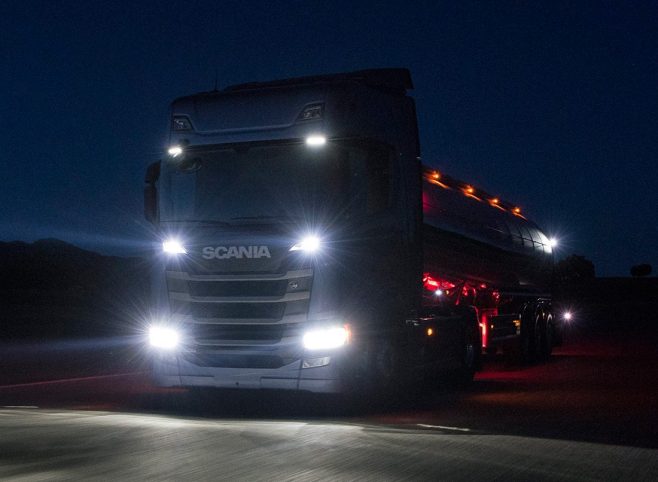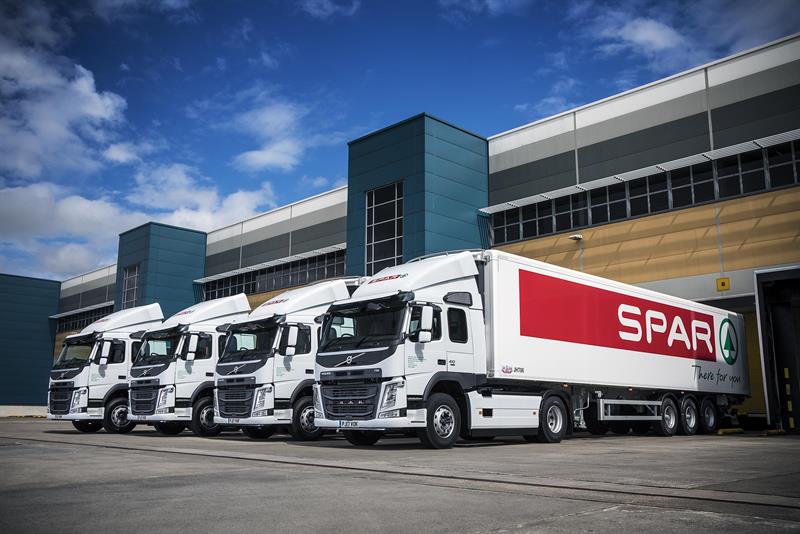
kscarbel2
Moderator-
Posts
17,893 -
Joined
-
Days Won
86
Content Type
Profiles
Forums
Gallery
Events
Blogs
BMT Wiki
Collections
Store
Everything posted by kscarbel2
-
Dana launches SPL 250 Lite driveshaft for heavy trucks
kscarbel2 replied to kscarbel2's topic in Trucking News
Dana launches new products at NACV Truck News / September 26, 2017 ATLANTA, Ga. – Dana has expanded its line of downspeeding-compatible driveshafts, with the introduction of the SPL 250 Lite. The company says the new offering reduces weight by up to 25 lbs compared to competitive products. It has been designed to reduce noise, vibration and harshness (NVH), while improving vehicle dynamics without compromising strength, the company announced at the North American Commercial Vehicle show. “The lower numeric axle ratios required to support engine downspeeding and improve fuel efficiency can cause significant stress to the drivetrain and alter harmonics in driveline components,” said Mark Wallace, executive vice-president of Dana and president of Dana Commercial Driveline Technologies. “Excessive vibration leads to unplanned downtime and driver fatigue on the road. The SPL 250 Lite driveshaft leverages proprietary precision manufacturing methods that ensure no NVH issues while delivering a smooth ride. It also reduces weight without sacrificing performance or durability.” Dana also announced the availability of an aluminum hub option on its Spicer D-Series steer axles with a 14,600-lb gross axle weight rating. It’s the industry’s only 14,600-lb rated integrated air disc brake steer axle available with the lightweight hub option, Dana claimed. It’s aimed at on-highway, city delivery, and vocational applications. “Dana now offers multiple options for the industry’s only integrated air disc brake steer axle that supports up to 14,600-lb GAWR, putting us in a unique position to offer our customers a choice on applications that cannot be matched,” said Wallace. “Spicer D-Series steer axles deliver best-in-class performance and durability, enabling improved vehicle stopping power and reduced maintenance without the added weight that typically results from specifying air disc brakes.” The company rounded out its news conference by announcing its Spicer S140 series single reduction, single drive axle can now be spec’d on Peterbilt medium-duty trucks. It’s available on 220, 330, 337, and 348 models with gross axle weight ratings from 17,000 to 21,000 lbs. Dana officials said the axle weighs up to 100 lbs less than competitive designs. -
Dana launches SPL 250 Lite driveshaft for heavy trucks
kscarbel2 replied to kscarbel2's topic in Trucking News
Dana debuts new driveshaft, hub option on Spicer D-Series Jason Cannon, Commercial Carrier Journal (CCJ) / September 26, 2017 Dana announced Tuesday at the North American Commercial Vehicle Show in Atlanta the launch of its SPL 250 Lite driveshaft. Optimized for the most popular configurations of heavy-duty commercial trucks and designed to handle torque ratings of more than 18,000 lbs.-ft., the SPL 250 accommodates the lower numeric axle ratios required to support engine downspeeding which can cause stress to the drivetrain and alter harmonics in driveline components. It has been engineered to reduce noise, vibration, and harshness (NVH) levels; improve performance; and enhance vehicle dynamics without compromising strength. “This drive shaft [features] improves balance for better NVH characteristics,” says Dana’s Director of Product Planning Steve Slesinski, adding the removal of components aided in a weight reduction of up to 25 pounds compared to other products. Dana is also adding an aluminum hub option on its Spicer D-Series steer axles with a 14,600- pound gross axle weight rating (GAWR) – the industry’s only 14,600-pound GAWR integrated air disc brake steer axle available with a lightweight hub option. The Spicer D-Series steer axles reduce weight by up to 76 pounds compared to existing solutions and the new option expands the previously released 10,000 to 13,200 pound GAWR range with aluminum hubs. Also announced Tuesday is the availability of the Spicer S140 Series single-reduction, single-drive axle is now available on Peterbilt class 6 and 7 trucks. Available as an option on Peterbilt models 220, 330, 337, and 348, the axle is designed to support applications with gross axle weight ratings (GAWR) from 17,000 through 21,000 pounds. It is available in a range of ratios from 3.31 to 6.50:1, supporting medium-duty pick-up and delivery trucks as well as municipal and utility vehicles. This axle also improves accessibility and versatility with up to one inch of additional ground clearance. . -
Neil Abt, Fleet Owner / September 26, 2017 ATLANTA. Dana Inc. announced several product enhancements on Sept. 26, including the launch of the SPL 250 Lite driveshaft for heavy-duty trucks. The new driveshaft is about 20 pounds lighter than competitive products, Steve Slesinski, director of product planning for Dana, said at a press event during the North American Commercial Vehicle (NACV) show. It has been engineered to reduce noise and vibration without impacting performance, he said. It will be formally launched in November, although some OEMs have already begun installing the driveshaft, Slesinski said. Earlier this year, Dana launched the SPL 350 Lite driveshaft. The two share service components, increasing ease of service and simplifying inventory for truck owners and service facilities. Dana also announced the addition of an aluminum hub option on Spicer D-Series steer axles with a 14,600-pound gross axle weight rating. The axles are targeted for on-highway, city-delivery, bus, and vocational applications. Also at NACV, Dana said its Spicer S140 Series single-reduction, single-drive axle is now available as an option on medium-duty vehicles from Peterbilt Motors Co.
-
Fleet Owner / September 26, 2017 OEM upgrades truck and engine offerings plus technologies and services, too. ATLANTA. A wide-ranging “talk show” format press conference held by Daimler Trucks North America (DTNA) at the inaugural North American Commercial Vehicle (NACV) show highlighted numerous product additions, upgrades and tweaks by the OEM. Freightliner Trucks is now adding new mid-roof cab configurations to its Cascadia Class 8 tractor aimed at regional overnight haulers and segments such as bulk haul and flat beds. Those configurations include 48-, 60- and 72-in. mid-roof XT sleeper cabs in both 116- and 126-inch bumper-to-back-of-cab (BBC) platforms. A “Driver Loft” option is available in the 72-in. mid-roof XT configuration, which also features a two-seat dinette/work table and opposing seating that can be folded flat to allow for a full “Murphy-style” bed to swing down in less than 15 seconds. All three configurations offer two levels of aerodynamic packages, the Aero or AeroX, as well, and customers can place orders for the new sleepers for delivery in January of 2018. Freightliner is also offering some new options for its severe-duty vocational truck models as well, which include: Availability of the Allison 4700 RDS automatic transmission for the Freightliner 114SD and 122SD models LifeGuard RollTek seats as an option, which come with side-impact airbags inflate, automatic seat belt tightening, and air-suspension compression to bring the seat the lowest position to provide additional protection to the driver. New standoff brackets and optimized routing and clipping of chassis electrical and plumbing harnesses to provide a cleaner installation and greater long-term durability. Freightliner M2 106 and M2 112 trucks can now be spec’d with modular LED headlights to improve night visibility and reduce maintenance costs. The Bendix Tire Pressure Monitoring System is now an option for Freightliner’s entire vocational product line A new Freightliner 122SD auto hauler package, made possible in collaboration with Fontaine Modification, Inc., which lowers the “laden roof” height to approximately 100-in. for applications that require a sleeper berth. Freightliner added that Cascadia tractors spec’d with a Detroit engine can soon tap into full over-the-air functionality of Detroit Connect Remote Updates, including the ability to remotely and securely program select engine parameters as well as accept Detroit-initiated firmware updates. Available in October, the parameter programming capability gives customers the flexibility to build their own parameter profiles using the Detroit Connect portal, which they can use to update one truck, a set of trucks, or their whole fleet at once, the OEM said. Freightliner is going to offer a Hendrickson OPTIMAAX 6x2 liftable forward tandem axle exclusive to its Cascadia tractor starting in October, which is designed to help truckers improve fuel economy with “diminishing loads,” like bulk haulers and delivery vehicles that may have empty back hauls after carrying items such as groceries, livestock, beverages and fuel. DTNA’s Western Star division is offering some new options on its line of trucks, including: Michelin X Multi D tires as a factory-installed option on Western Star 4700, 4800, 4900 and 5700XE models, ideally suited for regional applications such as dry van LTL, food & beverage, pick up & delivery, tankers, energy, and construction. New factory-direct H4 halogen headlight bulbs as an on Western Star 4700 models An expanded-capacity of its in-cab battery box to hold up to four batteries, available for Western Star 5700XE day cab models, with the batteries located under the passenger seat instead of the side of the chassis. New factory-installed LED headlights for Western Star 4800 and 4900 models On the school bus side of the house, DTNA’s Thomas Built Buses subsidiary is soon going to be able to equip its Saf-T-Liner C2 school buses with the new Detroit DD5 medium-duty engine. The Detroit DD5 and its bigger brother, the Detroit DD8, will be available for order in 2018 from any Thomas Built Buses dealer, the OEM noted. DTNA’s Detroit division is also rolling out a new offering: its Detroit Connect Analytics safety reporting feature will be included at no charge for five years with the purchase of the Detroit Assurance suite of safety systems on the new Freightliner Cascadia. That safety reporting feature will be available beginning in October this year and will also be offered retroactively at no charge for all new Cascadia tractors spec’d with Detroit Assurance built before October, the company said. The OEM is also introducing Express WriteUp, a new mobile application that allows service advisors to wirelessly create a complete repair order and then instantly load all warranty coverage, repair history and Detroit Connect Virtual Technicians details. Finally, the company announced that it has tripled online parts orders through its e-commerce platform, Pinnacle Truck Parts, which streamlines the parts ordering process by providing online, real-time competitive pricing and parts availability for over 650,000 store keeping units (SKUs) from dealer and parts distribution center inventories. .
-
Transport Topics / September 25, 2017 ATLANTA — Meritor Inc. announced new electrified axles, a value brand and refinements to existing components. The company made its announcements at the inaugural North American Commercial Vehicle Show here Sept. 26. Meritor is developing a platform of electric drive axles and suspensions as well as supporting systems, joining several suppliers’ emphasis on a range of electric solutions for the commercial vehicle market. “Essentially, we’re focusing on integrating an electric motor into the differential carrier,” Meritor CEO Jay Craig said in a statement. Its “e-carrier” design will be the foundation for various drivetrain configurations, including full electric, hybrid, single or tandem axles with various options based on application, according to Craig — including city delivery, medium-duty and transit bus, as well as off-road and severe-duty applications. Also, the company will offer braking systems optimized for e-axles. The next generation of its hydraulic and air disc brakes has been designed for use on hybrid or electric vehicles with regenerative braking. Both brake systems reduce weight on wheel-ends, according to Craig. In addition, Meritor announced a new value brand called Mach for global aftermarket customers seeking all-makes products designed and engineered to industry standards at affordable prices, according to the company. The brand is for second as well as third owners of trucks. The Mach-branded products include an assortment of suspension, steering, brake and drivetrain components that will be available initially in North America before the end of 2017 and will launch in Europe, South America and Australia at a later date, according to Meritor. Mach brand products come with a standard one-year warranty Plus, the company announced its automatic tire inflation system for trailers will include the ThermALERT wheel-end heat-sensing system as standard beginning in October 2017. The system immediately alerts drivers to overheating wheel-ends, increasing safety and minimizing vehicle downtime as well as costs, according to the company. Lastly, Meritor redesigned its EX+ air disc brake for tractors and trailers to reduce product weight by 10 pounds per brake, and it will be available to OEMs in 2018. Additionally, Meritor air disc brakes are compatible with most collision mitigation systems currently on the market, according to the company. Meritor Inc. is a leading global supplier of drivetrain, mobility, braking and aftermarket solutions for commercial vehicle and industrial markets.
-
Transport Topics / September 25, 2017 ATLANTA — Mack Trucks showed off its new Anthem highway tractor and clarified how it will be marketed relative to its long-standing Pinnacle highway model that remains available. The Greensboro, N.C.-based OEM said here on Sept. 26 that axle-back Anthem will be a highway-only model that will give Mack an entry into the longhaul market, especially when purchased with a 70-inch, stand-up sleeper cab. Pinnacle, often used in less-than-truckload and parcel transportation, will now be axle-forward only, a configuration often preferred by carriers hauling lots of weight. Anthem is designed for aerodynamic efficiency, whereas Pinnacle has a “classic look,” said John Walsh, Mack’s marketing vice president. Roy Horton, Mack director of product strategy, said that with the advent of Anthem, Pinnacle would be aimed at both highway and vocational applications. “It could be linehaul, heavy-haul or oilfield services for Pinnacle, and our MP8 engine is the only option,” Horton said, referring to Mack’s 13-liter power plant. In contrast, Anthem will have three engine choices: the 11-liter MP7, MP8 or a Cummins-Westport 12-liter natural gas model. Mack is a big manufacturer of vocational trucks for construction and refuse hauling, but Walsh said the company has been “unfairly pigeon-holed as vocational only.” The Mack presentation was part of the North American Commercial Vehicle Show. Jonathan Randall, a Mack senior vice president, said, “longhaul trucking is coming back,” and that Mack wants a piece of that market and will use Anthem to pursue it. “We’re back into markets where we hadn’t been a strong consideration,” Randall said of the company’s longhaul effort. Mack and Volvo Trucks North America are both part of Volvo Group, which recently raised its North American Class 8 sales forecast to 225,000 trucks this year, industrywide, from 215,000. Volvo Group management expects 2018 sales to rise over this year’s level, citing generally positive indicators for the U.S. economy. In addition to fuel-efficiency improvements, Horton said the Anthem’s design included input from drivers so as to add to their comfort. He said the tractor has 27 cubic feet of storage space throughout the cab in several locations. The tractor was launched in Allentown, Pa., in mid-September. .
-
Freightliner Offers New Cab Configurations for Cascadia
kscarbel2 replied to kscarbel2's topic in Trucking News
Freightliner Cascadia Adds Midroof Sleepers Transport Topics / September 25, 2017 ATLANTA — Daimler Trucks North America announced that its refreshed Freightliner Cascadia model will add midroof sleeper berths for regional overnight haul applications and segments such as bulk haul and flatbeds. The configurations include 48-, 60- and 72-inch midroof XT sleeper cabs in both 116- and 126-inch bumper to back of cab lengths. All three configurations offer two levels of aerodynamic packages, the Aero or AeroX, the company’s most fuel-efficient specification, according to DTNA. The truck gets LED-lit interior and exterior lights and an ergonomic dashboard and display screen designed to help drivers access gauges and switches without reaching. A loft option is available in the 72-inch midroof XT configuration features a two-seat dinette-work table and opposing seating. These seats can be folded flat to allow a full Murphy-style bed to swing down in less than 15 seconds, according to DTNA. “The addition of the midroof configuration allows more customers in different applications to experience the benefits of the new Cascadia,” said Mike McHorse, DTNA’s manager for on-highway product marketing. . -
Transport Topics / September 25, 2017 ATLANTA — Daimler Trucks North America expanded the powertrain offerings of its medium-duty Fuso cabovers with the introduction of an electric-powered version of its Fuso Canter truck, and a gasoline option for its FE-Series model. The powertrain of the Class 4 all-electric Fuso eCanter contains six 420-volt Mercedes-Benz lithium-ion battery packs with a total capacity of 82.8 kWh. The truck has a gross vehicle weight rating of 15,995 pounds, a range of more than 60 miles and a body/payload capacity of approximately 9,380 pounds, depending on body and usage, DTNA said in a release issued here at the inaugural North American Commercial Vehicle show. The company said that the eCanter offers operating cost savings up to $2,000 per 10,000 miles of operation when compared to an equivalent diesel truck. “This is really more than a product launch for us; it is a game changer, a revolution in the making,” Fuso CEO Jecka Glasman said. The first production models will reach customers this year in the United States, Europe and Japan, and Fuso plans to deliver 500 units of this generation to customers within the next two years. Larger scale production is intended to start in 2019. Plus, Fuso Vice President for Sales Operations Bill Lyons noted during the presentation that the next generation eCanter is already under development. Near-term, the first U.S. commercial partner for the eCanter will be UPS. “At UPS, we constantly evaluate and deploy advanced technologies that enable sustainable, innovative solutions for our fleet,” said Carlton Rose, UPS president for global fleet maintenance and engineering. “Electric trucks make our fleet both cleaner and quieter, adding to our already more than 8,500 alternative drivetrain vehicles in service today.” Other initial customers for the truck are coming through the office of New York Attorney General Eric Schneiderman, who is working with Fuso to supply a fleet of eCanters to New York-based not-for-profits, including the Wildlife Conservation Society, New York Botanical Garden, Habitat for Humanity New York City and Big Reuse Brooklyn. Operations looking for a gasoline-powered option will soon have it when Fuso adds a General Motors 6.0 engine to its FE-series lineup. The FE140 and FE160 will get the engine first; the gas-powered FE180 is still under development, Glasman said. All three trucks will also get an Allison 1000 six-speed automatic transmission, and will also offer power takeoff capability. The gas-powered FE-series trucks will be the first Fuso vehicles assembled in the United States, at Daimler’s Freightliner Custom Chassis Corporation factory in Gaffney, S.C., using engines and transmissions built in the U.S., and chassis, cabs and axles sourced from Fuso in Europe and Japan. Customer trials for a limited number of the gas trucks are scheduled to start in the fourth quarter, with full market launch to follow in the first quarter of 2018, as a 2019 model, Fuso said. . .
-
Navistar Announces New HV Severe Service Model Transport Topics / September 25, 2017 Further Integration With VW Moves Quickly ATLANTA — Navistar International Corp., the parent company of International Truck, announced its new HV model intended for severe service applications in North America. At the same, Navistar’s collaboration is accelerating with Volkswagen Bus & Truck, a unit of Volkswagen AG, with whom it forged an alliance in 2016, it said. The HV will be available with Navistar’s new 12.4 liter engine, the A26, which uses the MAN D26 crankcase, according to Navistar. MAN is a unit of Volkswagen Bus & Truck. “It’s all about [putting the] driver first. We designed this truck from the inside out imagining a space for drivers who operate these kinds of trucks,” said Denny Mooney, senior vice president of global product development. “Also, it is designed for easy body mounting [to accommodate various applications].” The company made its announcements at the inaugural North American Commercial Vehicle Show here Sept. 25. Meanwhile, the two truck makers agreed to collaborate on a fully integrated next generation “big bore” powertrain for Navistar, Navistar Chairman and CEO Troy Clarke said. “We believe a proprietary powertrain is important for Navistar, for dealers and, most importantly, for our customers.” Clarke declined to reveal details of the powertrain intended for North American customers at this time, citing competitive reasons. “It is set to launch as early as 2021,” he said, which is also when the first of three planned increases in greenhouse gas Phase 2 emissions requirements kicks in for medium- and heavy-duty trucks. The other two timetables are 2024 and 2027. Also, Navistar and Volkswagen Truck & Bus intend to converge their separate connectivity activities — Navistar’s OnCommand Connection and Volkswagen’s RIO — to a Volkswagen Truck & Bus “global connected vehicle platform,” according to Navistar. The initial step will be the adoption of common, in-cab connecting device hardware for a network with roughly 650,000 vehicles worldwide — of which, 350,000 are in the U.S. — thereby “making it the world’s largest global ecosystem for commercial vehicles, once the migration is completed,” Clarke said. Volkswagen Truck & Bus expects to launch the cloud-based, brand-independent platform by the end of the year, according to Navistar. “We don’t view it as there is a European cloud and a North American cloud. There is just a cloud and it is around the world,” Clarke said. “No matter where trucks are being run, there is a protocol so they can reach up and pull that data to drive their business systems.” Asked if the alliance was unfolding at the pace he expected, Andreas Renschler, head of VW’s global Truck & Bus division, said, “From my experience, it is much faster than I thought.” Clarke added: “I would have thought that we would still be grappling with a handful of issues around technical specs and stuff related to engines. I’m telling you, we got through that kind of stuff really quick. Or can we put together these two purchasing processes? That stuff was through in weeks. I didn’t think we’d be talking about electric trucks or merging our digitalization strategies, but it makes a lot of sense.” The alliance was completed in March. In the meantime, Navistar’s existing OnCommand Connection telematics product will be updated to include live action plans that predict when a part is going to fail before it actually does. The telematics system will then alert customers about the potential repair, the parts needed for the repair and the training needed for the repair, according to the company. The feature will be available in 2018. Also, the companies’ procurement joint venture based in Lisle, Ill., — Global Truck & Bus Procurement — has met with more than 250 new and existing suppliers, and completed 40 joint bidding contracts, according to Navistar. Navistar also said two-truck platooning using its vehicles, in cooperation with applications developer Peloton Technology, will be available in 2018, too. Plus, Navistar announced it will launch Classes 6-7 trucks with an electric powertrain in late 2019 or early 2020, given the trucks’ abundance of packaging space, and that they typically run short distances and can recharge at the end of the day. “Currently, the Cummins ISB engine is the mainstay of our medium-duty product. We don’t offer a different engine. It performs great. It has a great product following,” Clarke said. Also, Navistar has added updates to its HX series vocational trucks, including offering 51-inch sleepers in the 550 and 650 models, beginning in October. These two HX models also will be available with the A26 engine, starting in May 2018, according to the company. . .
-
Navistar, VW will collaborate on electric truck, connectivity
kscarbel2 replied to kscarbel2's topic in Trucking News
Navistar, VW to develop new diesel engines, medium-duty electric truck Neil Abt, Fleet Owner / September 25, 2017 ATLANTA - Navistar International Corp. said it plans to develop fully integrated diesel big bore powertrains in conjunction with Volkswagen Truck & Bus for the North American market in 2021. The announcement was part of a joint media event on Sept. 25 at the North American Commercial Vehicle show. VW last year agreed to purchase a 16.94% stake in Navistar – a deal that formally closed in March. At NACV, the companies also said they will develop an electric-powered, medium-duty vehicle for the United States and Canada in late 2019 or early 2020. “Our alliance with Volkswagen Truck & Bus is allowing us to move much more quickly into electric propulsion thanks to our ability to leverage their technology investments and components in segments of the market where we’re already a leader,” said Troy A. Clarke, Navistar’s chairman, president, and CEO. “We believe the Class 6/7 vehicle is ideal for electric powertrain solutions in the near term, given its abundance of packaging space, and that these vehicles typically run short distances and can depot to recharge at the end of the day.” During the press event, Clarke and Andreas Renschler, CEO of Volkswagen Truck & Bus, unveiled the companies will converge their connectivity platform – Navistar’s OnCommand Connection and VWs RIO – creating a single global connected platform that would cover about 650,000 vehicles worldwide. That will begin with the adoption of common, in-cab connecting device hardware. Apart from the news related to the joint venture, Navistar shared a series of other developments, including the launch of the HV truck available with the International A26 12.4 liter engine. Additionally, it said a 51-inch sleeper cab is now an available for both its HX520 and HX620 vocational models. The A26 engine is also now an option for the full HX series, Navistar said. Several upcoming enhancements to OnCommand Connection were also shown, including a “live action” feature that can better predict problems with parts before there is a failure. . -
Navistar, VW will collaborate on electric truck, connectivity
kscarbel2 replied to kscarbel2's topic in Trucking News
Navistar-VW Alliance to Bring Electric Truck, Integrated Powertrain to Market Heavy Duty Trucking (HDT) / September 25, 2017 ATLANTA – The Navistar-Volkswagen Truck & Bus Alliance has borne fruit faster than either company expected, and officials announced Monday at the inaugural North American Commercial Vehicle Show. they will develop a proprietary, integrated powertrain; a common connected vehicle and cloud platform; and an electric-powered Class 6/7 truck. Navistar expects to be in a position to launch its first medium-duty electric powered vehicle for the U.S. and Canadian markets in late 2019 or early 2020. "We believe the Class 6/7 vehicle is ideal for electric powertrain solutions in the near term, given its abundance of packaging space, and that these vehicles typically run short distances and can depot to recharge at the end of the day,” said Troy A. Clarke, chairman, president and CEO, Navistar. Clarke pointed out that Navistar was “probably ahead of its time” when it launched the eStar electric vehicle back in 2010, “but we never gave up believing there is an application for electric commercial vehicles in the North American commercial vehicle market,” he said. Clarke also noted that electric power for commercial vehicles is particularly growing in urban areas, “where congestion often leads to air quality issues.” In fact, Volkswagen has already delivered the first 10 electric trucks to an Austrian customer for testing, said Andreas Renschler, CEO of Volkswagen Truck & Bus. “For us, the customer’s view is first and foremost in priority. If the customer tells us what he or she wants to do with electric trucks we can deliver.” Renschler said he couldn’t answer media questions about things like how many such vehicles they expect to sell, because “Of course it depends on customers. The question for us is not to tell them what to do; they tell us what we should do with such a solution, but we can offer the innovation. I think electrical buses for example are important, but also the medium truck, with so called last mile, we see a good chance for the customer to be able to use it.” Integrated Powertrain In preparation for the next greenhouse gas emission regulations globally, Navistar and VW also are collaborating on a fully integrated, next-generation diesel big bore powertrains for North America, launching in 2021. However, the two companies would offer no further details. “We'd love to say a lot more about that,” Clarke said, but didn’t want to divulge too much of the company’s future plans for fear of how the competition might use it against them. “I guarantee you this, the next one of these shows in 2019 it will all be very evident.” Asked if the powertrain would also include a proprietary transmission, Clarke and Renschler were noncommittal, saying such things were “possible.” Converging Connectivity Navistar and Volkswagen Truck & Bus also announced their intention to converge their connectivity activities – OnCommand Connection and RIO, Volkswagen Truck & Bus's digital brand – to a Volkswagen Truck & Bus global connected vehicle platform. The first step will be the adoption of common, in-cab connecting device hardware. This would serve as a major step toward creating a global connected platform, covering roughly 650,000 vehicles worldwide, "making it the world's largest global ecosystem for commercial vehicles, once the migration is completed," Clarke said. Volkswagen Truck & Bus expects to launch the cloud-based, brand-independent platform by the end of the year, which will be the basis for the cooperation. "Future transportation will massively be building on connectivity, as this will make our world much more efficient," said Renschler. "The ecosystem we are about to create with our common platform will drive our strategic alliance to the next level." Joint Venture Navistar also reported that the procurement joint venture – Global Truck & Bus Procurement LLC – it created with Volkswagen Truck & Bus is off to a strong start. The team has met with more than 250 new and existing suppliers, and to date, have completed 40 joint bidding contracts. "We're on track to achieve our expected cost savings thanks to our fast start with the procurement JV and the great progress on our technology collaboration," said Clarke. "As a result, we are in a much more competitive position today in the areas that are quickly revolutionizing our industry globally.” “Navistar is now writing the next chapter of our story,” Clarke said. “Unlike any time in our history, we are positioned to win, and we will. We have the products, we have the dealers, we have the partner, and most importantly we have the will to win. We have the resolve to fight the next battle and the one after that.” . -
Nikola Taps Bosch for eAxle, Other Key Components Transport Topics / September 25, 2017 Nikola Motor Co. announced Bosch Group will play a key role in supplying powertrain components for its over-the-road and day cab Class 8 hydrogen-electric trucks, which are scheduled to come to market in 2021. Stuttgart, Germany-based Bosch will supply Nikola with its eAxle, which has a motor, power electronics and transmission in one compact unit, according to Salt Lake City-based Nikola. The companies also announced they will jointly develop a custom-designed fuel cell system for the trucks. The overall vehicle controls will be jointly developed based upon Bosch’s vehicle control software and hardware. Referring to it as the “Nikola Bosch zero local emission powertrain,” the truck maker said in a statement that the system is designed to achieve “segment-leading performance” at a competitive total cost of ownership to traditional powertrains. “Bosch has empowered us to come to market quickly with automotive-grade hardware and software so our vision can become a reality,” Nikola founder and CEO Trevor Milton said in a statement. The trucks, first announced in December 2016, are intended to deliver more than 1,000 horsepower and 2,000 pound-feet of torque, according to Nikola. .
-
Ford Ranger interior spied during testing Automotive News / September 26, 2017 The interior of the 2019 Ford Ranger may look similar to that of the midsize pickup now sold in markets outside the U.S. Spy photos of a camouflaged Ranger testing in Colorado show a small infotainment screen flanked by a series of buttons. Underneath the screen are more buttons with two dials for volume and radio tuning. It's a design used on Rangers sold in Australia and other markets. The automaker also offers larger touch screens depending on the trim. The U.S. prototype's center console between the seats was not visible because of testing equipment. It's unclear how much of the prototype's interior design will carry over to production models. Ford traditionally does not comment on future products or camouflaged vehicles in spy photos. The photos also show more of the front grille than previous spy shots, with what appears to be Ford's standard tribar grille design. The spy photos also appear to show a more aggressive exterior design with a front skid plate and tow hooks mounted in the front bumper, suggesting Ford could offer an FX4 off-road package. Ford this year reintroduced an FX4 package for its redesigned 2018 Expedition SUV. Previous spy photos also suggest Ford will offer a Ranger Raptor variant. It's unclear what engine options the Ranger will have, but the engines are expected to be paired with Ford's new 10-speed transmission, which the automaker is rolling out across its lineup. Ford in January confirmed plans to revive the Ranger after years of rumors, with production of the 2019 model beginning late next year at the Michigan Assembly Plant in Wayne, Mich. It will compete in a segment that includes the Chevrolet Colorado, GMC Canyon and Toyota Tacoma. Ford last sold the Ranger in the U.S. in 2012, but it continues to build and sell it globally. Photo gallery - http://www.autonews.com/article/20170926/OEM04/170929846/2019-ranger-ford-spy-photo-interior .
-
Dressing for the job – Scania’s new construction clothes collection
kscarbel2 replied to kscarbel2's topic in Trucking News
-
You're welcome. I aim to please.
-
Iconic Australian Routes: Cannington Mine to Yurbi Rail
kscarbel2 replied to kscarbel2's topic in Trucking News
Related reading: https://www.bigmacktrucks.com/topic/47348-lindsay-fox-vows-to-never-retire/?tab=comments#comment-349310 -
Linfox Press Release / July 12, 2017 .
-
I happened upon a read on this subject. --------------------------------------------------------------------------------------------------- NFL should follow NCAA lead on national anthem at games Kerry Dougherty, News columnist / September 23, 2017 Can we all agree that college football is more fun to watch than the NFL? And not just because the pros are filled with grown men grinding for a paycheck, while most college players are barely out of their teens and prone to both crazy mistakes and brilliant plays. Sure, college teams in the Power Five are sprinkled with freaky athletes who have taken cash and swag under the table, but there are plenty of absolute amateurs: players who were overlooked in high school and guys simply playing a sport they love, knowing they’ll never go pro. Shoot, you didn’t have to be a Clemson fan to find yourself cheering for Cinderella wide receiver Hunter Renfrew in last January’s national championship win over Alabama. The Myrtle Beach native joined the Tigers as an undersized walk-on, only to become the star of the best team in college football. There’s another reason to prefer the NCAA over the NFL right now: The relative absence of politics and protests. At many college games, the national anthem is played while the players are still in the locker room. This has been the case for many years and apparently has to do with television schedules and the need to be ready to kick off at the precise moment the cameras blink on. I thought of that last Saturday night as I stood in the stands at Cal Berkeley. The players for both teams were off the field when the marching band began to play “The Star-Spangled Banner.” I saw thousands of football fans in this left-leaning oasis proudly wearing “Cal” jerseys, with their hands over their hearts, warbling the lyrics loudly and off-key just like fans everywhere. It was a beautiful moment. So why don’t NFL owners adopt the same schedule? Play the anthem while the players are in the tunnel. That way team members aren’t pressured to stand. And ticket holders are spared the spectacle of players kneeling. Problem solved. By now even those who don’t know a tailback from a touchback are aware that former San Francisco 49ers quarterback Colin Kaepernick started taking a knee during the anthem last season. That attention-grabbing act, by a player whose career was already in a slump, ignited other protests with players on various teams sitting or kneeling during the anthem as fans fumed in the stands. As I wrote last year, Kaepernick had a right to his nonviolent protest, just as some of us had a right to call his behavior rude. Look, politics are everywhere. And most of what passes for politics is ugly. Football is where some of us go to escape. We don’t want to be lectured or drawn into divisive debates while there, whether the instigators are players, owners, announcers, or quite frankly, the president of the United States. In a red meat speech at a political rally for Republican U.S. Senate candidate Luther Strange in Alabama on Friday night, President Donald Trump foolishly waded into the NFL controversy. He suggested that the protests would end if fans simply walked out every time players fell to their knees during the anthem. What, and miss the game, Mr. President? Those season tickets cost big bucks. Plus, people love football. The president urged owners to fire protesting players. “Wouldn’t you love to see one of these NFL owners, when somebody disrespects our flag, to say, ‘Get that son of a bitch off the field right now, out, ” Trump intoned, launching yet another controversy. he’s fired,’ Our bombastic president is partly right, owners can hire or fire players at will — depending on their clauses in their contracts, that is. But by popping off about the issue, Trump virtually guaranteed that the protests will continue. And spread. Look, standing for the national anthem is simply a sign of respect and affection for our imperfect nation. It doesn’t suggest agreement with everything going on in the country. If it did, no one would stand. Instead of kicking protesters off them team as Trump urged, owners should urge their players to follow their consciences. Tell them that they’re free to stand, sit or kneel. In the locker room.
-
-
Hyundai Commercial Vehicle Press Release / September 12, 2017 .
-
Daimler launches Mitsubishi Fuso eCanter in US market
kscarbel2 replied to kscarbel2's topic in Trucking News
-
Bharat Benz Press Release / September 22, 2017 Five years ago we introduced our first truck in India. To celebrate our anniversary we went on our biggest adventure yet. During our High Five Rally, we traveled 9000 kilometers in 35 days across the country to thank customers, fleet owners, dealers and truck drivers. Watch this video for impressions of our epic journey! Thank you for your trust! .
-
Transport Engineer / September 18, 2017 Spar wholesaler and distributor James Hall & Co has taken delivery of eight new Volvo trucks, six FM 4x2 tractors and two FE 6x2 rigids. Supplied by Thomas Hardie Commercials, the Lancashire-based operator’s new additions will serve 600 Spar stores in the north of England. The trucks all feature the Volvo 11-litre engine, rated at 410bhp in the tractors and 320bhp in the rigids, plus the I-Shift automated transmission. All are on seven-year Volvo Gold R&M contracts with the dealer. Ian Farnworth, fleet engineering manager, says the tractors are ideal for the delivery operation: “The FM has very good low entry which suits a multi-drop operation.” He adds: “Every vehicle we have is potentially operating in a multi-drop environment.” Farnworth says the decision was taken to specify the single-drive three-axle rigids, rather than two-axles, to meet the changing profile of the stores the company delivers to – making it possible for them to accommodate a larger delivery vehicle. The new vehicles join an 86-strong fleet, of which 52 are now Volvo trucks. There is an equal split between artics and rigids, with the artic fleet operating at a maximum gcw of 40 tonnes The operator runs some Gray & Adams 13.6 metre, dual-temperature, double-deck fridge trailers as well as a number of 11.2m dual-temperature spec tandems from the same manufacturer. .
BigMackTrucks.com
BigMackTrucks.com is a support forum for antique, classic and modern Mack Trucks! The forum is owned and maintained by Watt's Truck Center, Inc. an independent, full service Mack dealer. The forums are not affiliated with Mack Trucks, Inc.
Our Vendors and Advertisers
Thank you for your support!


